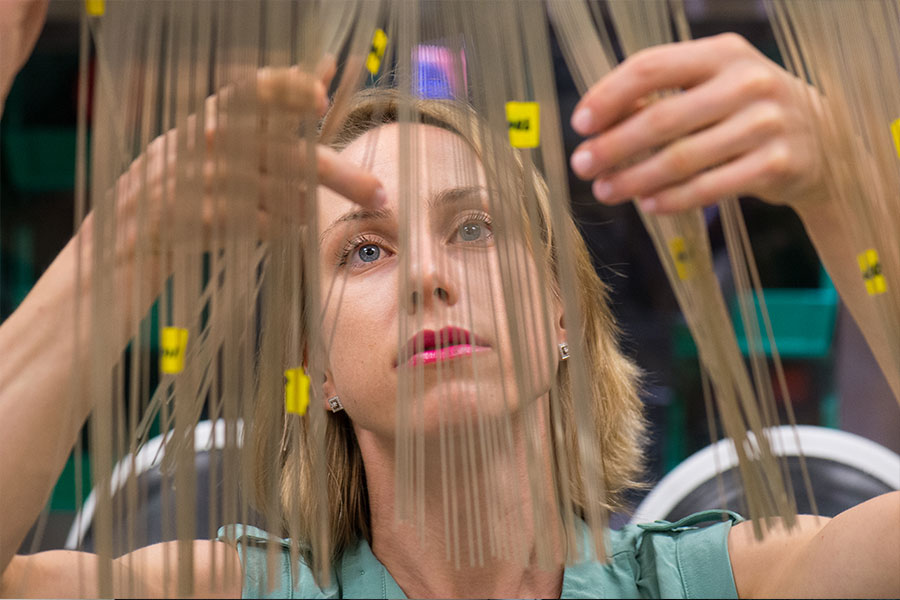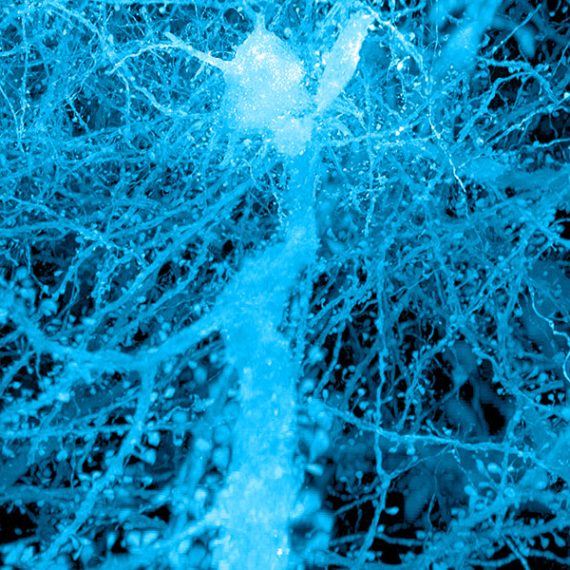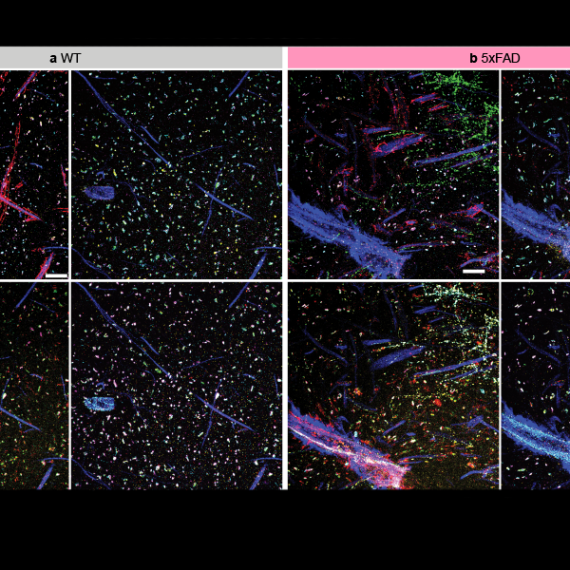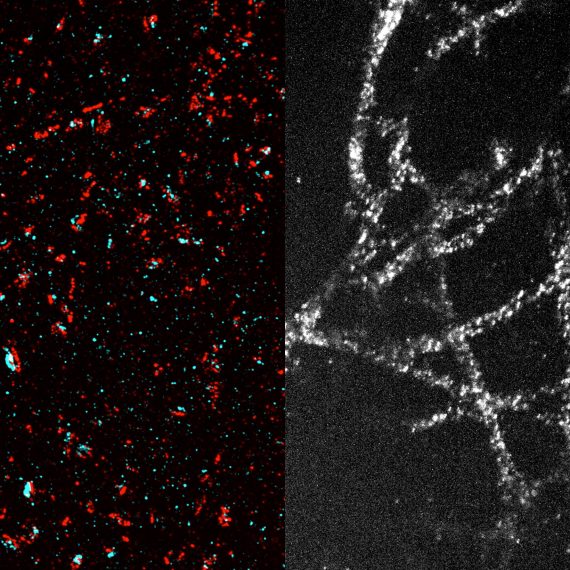Plugging into the brain
Inspired by engineering and electronics, Polina Anikeeva is focused on pioneering approaches to brain research and therapeutics.

Driven by curiosity and therapeutic goals, Anikeeva leaves no scientific stone unturned in her drive to invent neurotechnology.
The audience sits utterly riveted as Polina Anikeeva highlights the gaps she sees in the landscape of neural tools. With a background in optoelectronics, she has a decidedly unique take on the brain.
“In neuroscience,” says Anikeeva, “we are currently applying silicon-based neural probes with the elastic properties of a knife to a delicate material with the consistency of chocolate pudding—the brain.”
A key problem, summarized by Anikeeva, is that these sharp probes damage tissue, making such interfaces unreliable and thwarting long term brain studies of processes including development and aging. The state of the art is even grimmer in the clinic. An avid climber, Anikeeva recalls a friend sustaining a spinal cord injury. “She made a remarkable recovery,” explains Anikeeva, “but seeing the technology being used to help her was shocking. Not even the simplest electronic tools were used, it was basically lots of screws and physical therapy.” This crude approach, compared to the elegant optoelectronic tools familiar to Anikeeva, sparked a drive to bring advanced materials technology to biological systems.
Outside the box
As the group breaks up after the seminar, the chatter includes boxes, more precisely, thinking outside of them. An associate professor in material sciences and engineering at MIT, Anikeeva’s interest in neuroscience recently led to a McGovern Institute appointment. She sees her journey to neurobiology as serendipitous, having earned her doctorate designing light-emitting devices at MIT.
“I wanted to work on tools that don’t exist, and neuroscience seemed like an obvious choice. Neurons communicate in part through membrane voltage changes and as an electronics designer, I felt that I should be able to use voltage.”
Comfort at the intersection of sciences requires, according to Anikeeva, clarity and focus, also important in her chief athletic pursuits, running and climbing. Through long distant running, Anikeeva finds solitary time (“assuming that no one can chase me”) and the clarity to consider complicated technical questions. Climbing hones something different, absolute focus in the face of the often-tangled information that comes with working at scientific intersections.
“When climbing, you can only think about one thing, your next move. Only the most important thoughts float up.”
This became particularly important when, in Yosemite National Park, she made the decision to go up, instead of down, during an impending thunderstorm. Getting out depended on clear focus, despite imminent hypothermia and being exposed “on one of the tallest features in the area, holding large quantities of metal.” Polina and her climbing partner made it out, but her summary of events echoes her research philosophy: “What you learn and develop is a strong mindset where you don’t do the comfortable thing, the easy thing. Instead you always find, and execute, the most logical strategy.”
In this vein, Anikeeva’s research pursues two very novel, but exceptionally logical, paths to brain research and therapeutics: fiber development and magnetic nanomaterials.
Drawing new fibers
Walking into Anikeeva’s lab, the eye is immediately drawn to a robust metal frame containing, upon closer scrutiny, recognizable parts: a large drill bit, a motor, a heating element. This custom-built machine applies principles from telecommunications to draw multifunctional fibers using more “brain-friendly” materials.
“We start out with a macroscopic model, a preform, of the device that we ultimately want,” explains Anikeeva.
This “preform” is a transparent block of polymers, composites, and soft low-melting temperature metals with optical and electrical properties needed in the final fiber. “So, this could include
electrodes for recording, optical channels for optogenetics, microfluidics for drug delivery, and one day even components that allow chemical or mechanical sensing.” After sitting in a vacuum to remove gases and impurities, the two-inch by one-inch preform arrives at the fiber-drawing tower.
“Then we heat it and pull it, and the macroscopic model becomes a kilometer-long fiber with a lateral dimension of microns, even nanometers,” explains Anikeeva. “Take one of your hairs, and imagine that inside there are electrodes for recording, there are microfluidic channels to infuse drugs, optical channels for stimulation. All of this is combined in a single miniature form
factor, and it can be quite flexible and even stretchable.”
Construction crew
Anikeeva’s lab comprises an eclectic mix of 21 researchers from over 13 different countries, and a range of expertises, including materials science, chemistry, electrical and mechanical engineering, and neuroscience. In 2011, Andres Canales, a materials scientist from Mexico, was the second person to join Anikeeva’s lab.
“There was only an idea, a diagram,” explains Canales. “I didn’t want to work on biology when I arrived at MIT, but talking to Polina, seeing the pictures, thinking about what it would entail, I became very excited by the methods and the potential applications she was thinking of.”
Despite the lack of preliminary models, Anikeeva’s ideas were compelling. Elegant as the fibers are, the road involved painstaking, iterative refinement. From a materials perspective, drawing a fiber containing a continuous conductive element was challenging, as was validation of its properties. But the resulting fiber can deliver optogenetics vectors, monitor expression, and then stimulate neuronal activity in a single surgery, removing the spatial and temporal guesswork usually involved in such an experiment.
Seongjun Park, an electrical engineering graduate student in the lab, explains one biological challenge. “For long term recording in the spinal cord, there was even an additional challenge as the fiber needed to be stretchable to respond to the spine’s movement. For this we developed a drawing process compatible with an elastomer.”
The resulting fibers can be deployed chronically without the scar tissue accumulation that usually prevents long-term optical manipulation and drug delivery, making them good candidates for the treatment of brain disorders. The lab’s current papers find that these implanted fibers are useful for three months, and material innovations make them confident that longer time periods are possible.
Magnetic moments
Another wing of Anikeeva’s research aims to develop entirely non-invasive modalities, and use magnetic nanoparticles to stimulate the brain and deliver therapeutics.
“Magnetic fields are probably the best modality for getting any kind of stimulus to deep tissues,” explains Anikeeva, “because biological systems, except for very specialized systems, do not perceive magnetic fields. They go through us unattenuated, and they don’t couple to our physiology.”
In other words, magnetic fields can safely reach deep tissues, including the brain. Upon reaching their tissue targets these fields can be used to stimulate magnetic nanoparticles, which might one day, for example, be used to deliver dopamine to the brains of Parkinson’s disease patients. The alternating magnetic fields being used in these experiments are tiny, 100-1000 times smaller than fields clinically approved for MRI-based brain imaging.
Tiny fields, but they can be used to powerful effect. By manipulating magnetic moments in these nanoparticles, the magnetic field can cause heat dissipation by the particle that can stimulate thermal receptors in the nervous system. These receptors naturally detect heat, chili peppers and vanilla, but Anikeeva’s magnetic nanoparticles act as tiny heaters that activate these receptors, and, in turn, local neurons. This principle has already been used to activate the brain’s reward center in freely moving mice.
Siyuan Rao, a postdoc who works on the magnetic nanoparticles in collaboration with McGovern Investigator Guoping Feng, is unhesitating when asked what most inspires her.
“As a materials scientist, it is really rewarding to see my materials at work. We can remotely modulate mouse behavior, even turn hopeless behavior into motivation.”
Pushing the boundaries
Such collaborations are valued by Anikeeva. Early on she worked with McGovern Investigator Emilio Bizzi to use the above fiber technology in the spinal cord. “It is important to us to not just make these devices,” explains Anikeeva, “but to use them and show ourselves, and our colleagues, the types of experiments that they can enable.”
Far from an assembly line, the researchers in Anikeeva’s lab follow projects from ideation to deployment. “The student that designs a fiber, performs their own behavioral experiments, and data analysis,” says Anikeeva. “Biology is unforgiving. You can trivially design the most brilliant electrophysiological recording probe, but unless you are directly working in the system, it is easy to miss important design considerations.”
Inspired by this, Anikeeva’s students even started a project with Gloria Choi’s group on their own initiative. This collaborative, can-do ethos spreads beyond the walls of the lab, inspiring people around MIT.
“We often work with a teaching instructor, David Bono, who is an expert on electronics and magnetic instruments,” explains Alex Senko, a senior graduate student in the lab. “In his spare time, he helps those of us who work on electrical engineering flavored projects to hunt down components needed to build our devices.”
These components extend to whatever is needed. When a low frequency source was needed, the Anikeeva lab drafted a guitar amplifier.
Queried about difficulties that she faces having chosen to navigate such a broad swath of fields, Anikeeva is focused, as ever, on the unknown, the boundaries of knowledge.
“Honestly, I really, really enjoy it. It keeps me engaged and not bored. Even when thinking about complicated physics and chemistry, I always have eyes on the prize, that this will allow us to address really interesting neuroscience questions.”
With such thinking, and by relentlessly seeking the tools needed to accomplish scientific goals, Anikeeva and her lab continue to avoid the comfortable route, instead using logical routes toward new technologies.




